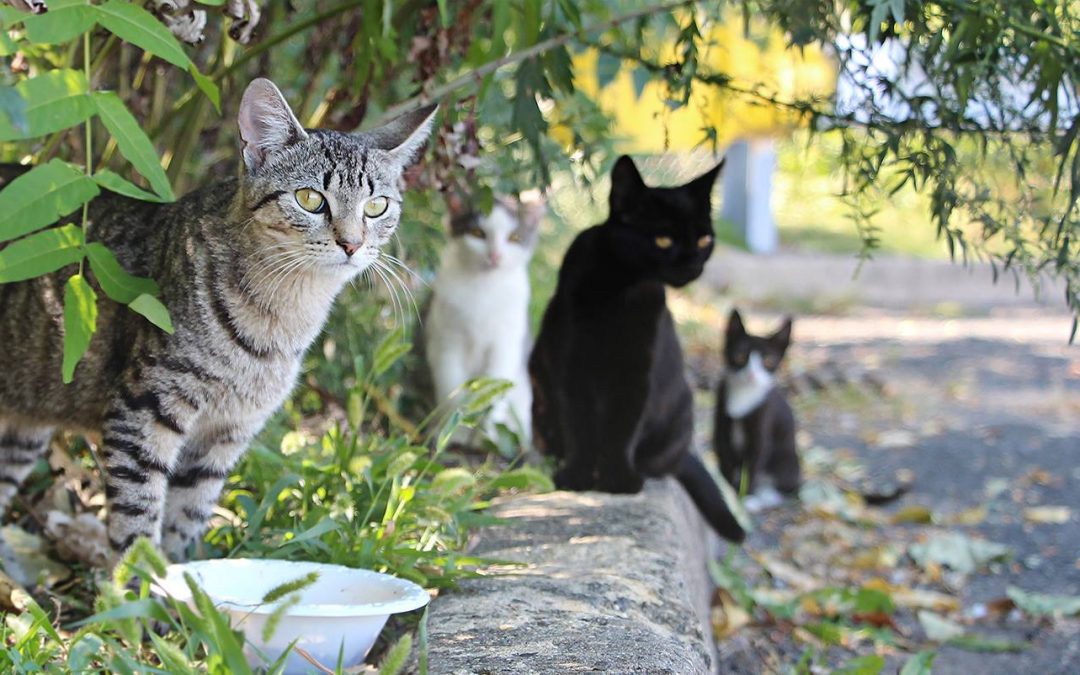Here’s an easy chart to check the difference between Stray and Feral Cats. For more in-depth, and interesting, information on all things stray & feral cats check out the website “AlleyCats.org”, a great Cat website.
| STRAY | FERAL |
| SOCIALIZATION TO HUMANS | |
| May approach people, houses, porches, or cars | Will not approach and will likely seek hiding places to avoid people |
| SOCIALIZATION TO OTHER CATS | |
| Will likely live alone, not be part of a group | May belong to a colony |
| BODY LANGUAGE | |
| Might walk and move like a house cat, such as walking with tail up—a sign of friendliness
|
May crawl, crouch, stay low to the ground, and protect body with tail |
| Will probably look at you, blink, or make eye contact | Unlikely to make eye contact |
| VOCALIZATION | |
| May be vocal, meow, or “answer” your voice | Won’t meow, beg, or purr |
| SCHEDULE | |
| Will be visible primarily during the daytime | More likely to be nocturnal; occasionally out during the day |
| PHYSICAL APPEARANCE | |
| Will probably be dirty or disheveled
|
Will probably have a clean, well-kept coat.
A male with a big head and thick neck, muscular body, and/or scars from fighting is more likely to be feral, since these are traits associated with intact males (and only 2% of feral cats are neutered in the U.S.). He may also have a spiky coat from high testosterone levels and less time spent grooming; may also have “stud tail”—hair loss, greasiness, or bumps at the base of the tail due to hormones. |
| Will not have an eartip | Will likely have an eartip if neutered as part of a TNR program |
| PREGNANCY, NURSING, KITTENS | |
| A female who is pregnant or lactating is more likely to be feral, since only 2% of feral cats are neutered in the U.S. | |
Alley Cat Allies recognizes that a cat’s level of socialization and behavior is not always black and white, particularly for feral cats who recognize their caregiver. They may show signs of familiarity, such as a tail up or hanging out on a caregiver’s porch, but these behaviors are usually limited to the cat’s interaction with the caregiver and only develop after building a relationship over time. Always remember: this does not mean that the cat is a good candidate for living indoors.
How do I tell feral and stray cats apart once I have trapped them?
When in a frightening or stressful environment—such as a trap or a shelter—a friendly stray cat may act like a feral cat, avoiding people and possibly even showing aggression to avoid being touched. “A lot of cats seem feral in traps but are just afraid,” explains Alley Cat Allies Feral Friend Genevieve Van de Merghel. Who can blame them? The cat is in a new and unfamiliar place.
Here are some ways that will help distinguish a feral cat from a scared stray cat when they are frightened, confined, or in a new place.
| STRAY | FERAL |
| TOUCHING/HANDLING | |
| It may be possible to touch the cat eventually or she may tolerate a small amount of touching with an object | Can not be touched, even by a caregiver |
| CAGE BEHAVIOR | |
| May come to the front of the cage
|
Will likely stay in the back of the cage and retreat as far back as possible
|
| May eventually rub against the cage in a friendly way | If jolted or frightened, may shake, rattle, or climb the cage, and could become injured banging into the cage |
| LEVEL OF RELAXATION | |
| May relax over time | Will remain tense and unsocial |
| RESPONSIVENESS | |
| May investigate toys or food placed near the cage | Will likely ignore all people and toys, and possibly even food |
| May respond to household sounds like cat food cans or bags being opened | Will not show any familiarity or interest in household sounds |
| FEAR AND ANXIETY | |
| May hiss or growl to show anxiety | Will be aggressive and lash out if threatened or cornered (signs of aggression include ears back and eyes dilated) |











